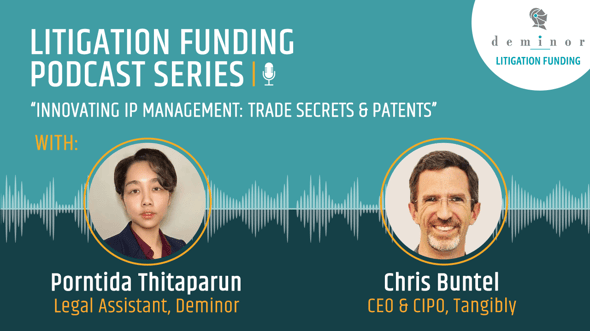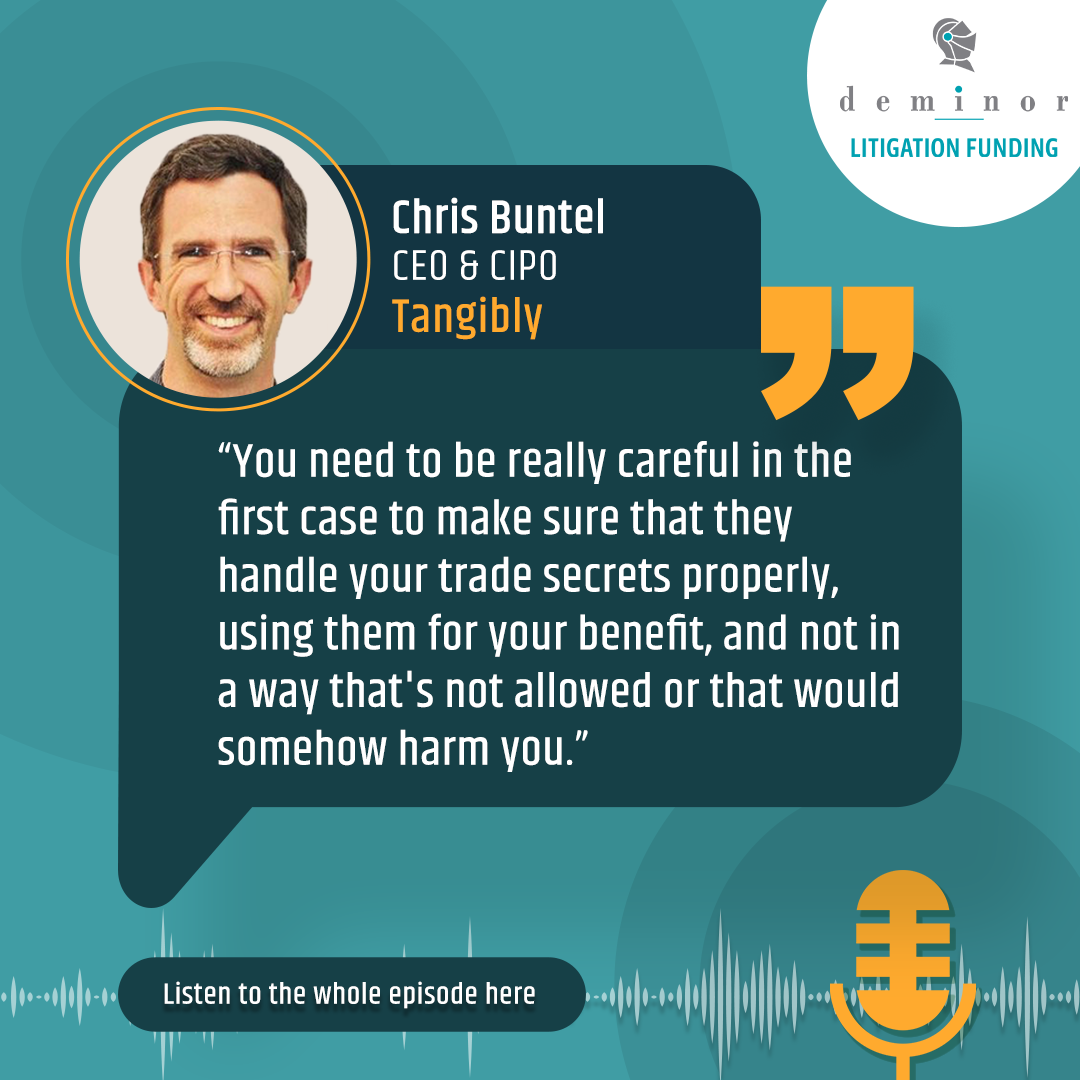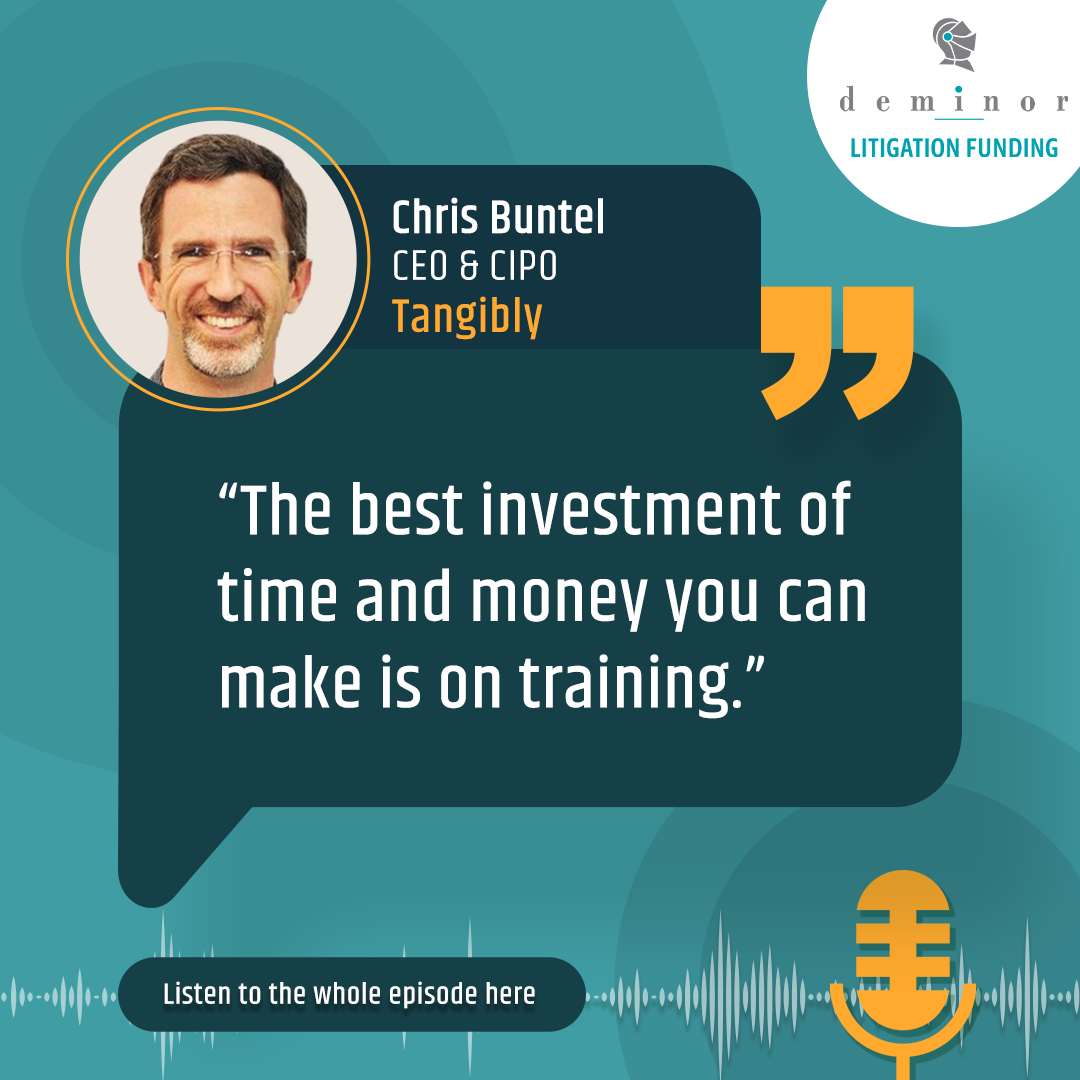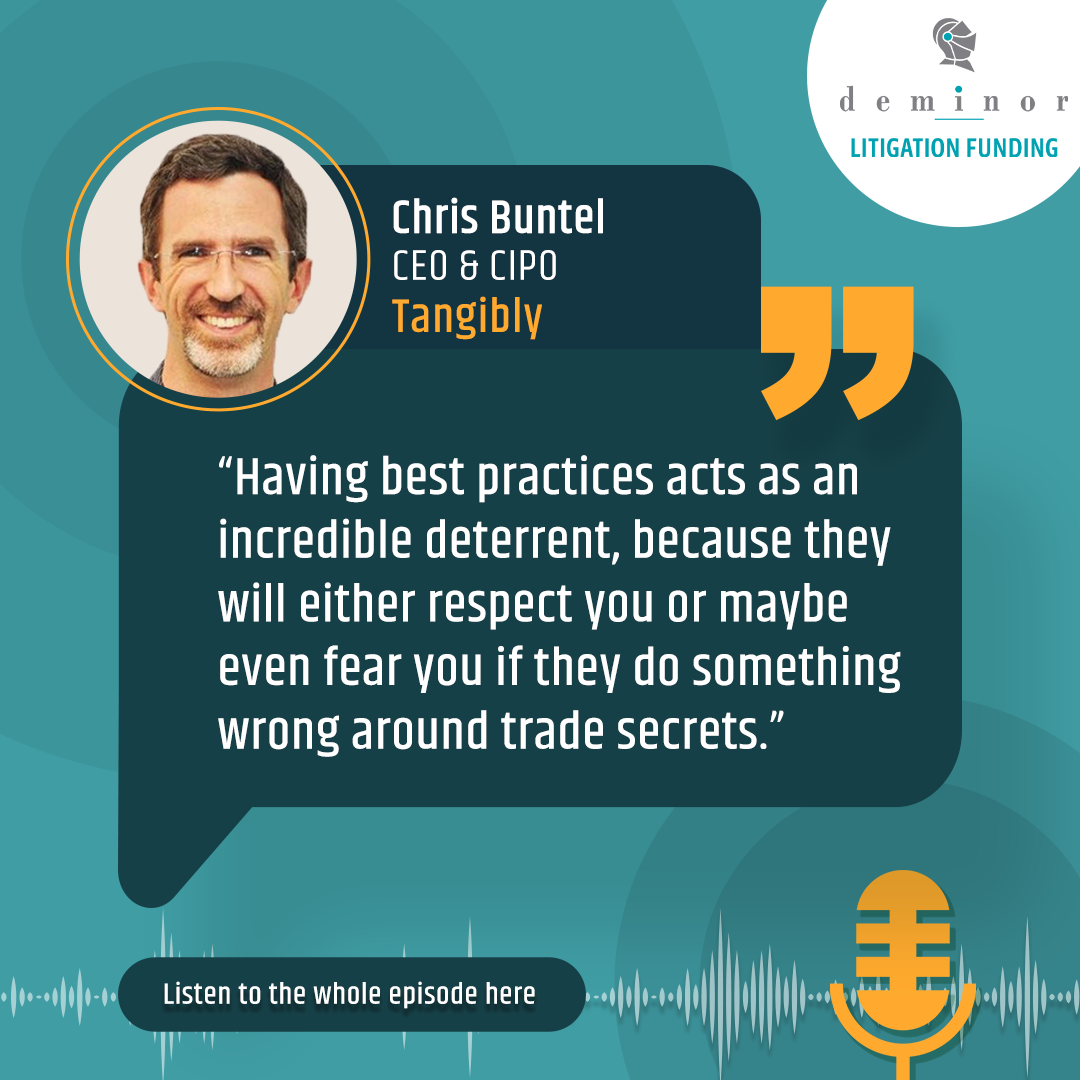In this podcast series, Deminor Litigation Funding, interviews global professionals to discuss different aspects of litigation and litigation funding.
Deminor welcomes you to join this conversation as we summarise the key elements of the discussions with these experts, as captured in the podcast transcripts below.

Podcast Preface:
Deminor Legal Assistant Porntida Thitaparun (PT), speaks with Chris Buntel (CB), experienced attorney and co-founder of Tangibly, a platform designed to help companies manage and protect their trade secrets.
In this interview with Porntida, Chris explains why more companies are choosing to protect their IP through trade secrets rather than patents. He outlines the key points when companies are most at risk of losing their trade secrets and describes what best practice looks like when it comes to managing risk and protecting trade secrets.
Podcast Transcript:
PT – We’re seeing more companies using trade secrets rather than patents to protect some of their technical IP. Can you explain why this might be happening?
CB – There are a lot of different reasons why we're seeing this shift from patents to trade secrets. It used to be that you would just patent everything. Life was simple. Any new technology, you would just file a patent. And almost without thinking, this was the pattern. What we've seen over the last maybe five or ten years, is a shift away from patents, and it's really much harder to get a patent in the first place than it used to be. Maybe the bar has been raised, or maybe certain technologies that used to be patentable are just impossible to patent now. It can seem as though, no matter how good your technology is, you just can't get a patent.
Patents are also becoming increasingly expensive to get, and they're even more expensive to enforce. You need to have a lot of zeros in your budget, so it's not something that a small inventor or an SME can easily get into because the ticket price is so high.
We're also seeing technology move faster and faster every year, and the patent process, as you may know, is pretty slow. So the time from filing a patent application to actually getting an enforceable granted patent can take two to four years, sometimes even longer. By the time you get your patent, technology may have moved on and evolved so much that this patent that you spent all of this time and money getting doesn't even cover your product anymore. So it's kind of a nonsensical situation for a lot of people.
Now, I'm not saying that patents are bad and trade secrets are good, but patents are just less attractive than they used to be.
PT – You mention a lot of risk for patents and how it's less attractive these days. What are the key events that present the most risk around trade secrets?
CB – There are three key points when people see or encounter risks around trade secrets. One of them everyone thinks of without fail. The other two are often overlooked, or at least they aren’t given as much attention as they should. So the one that everyone thinks of is when existing employees leave the organisation. So everyone is worried about this employee, who had access to all of the valuable trade secrets, who is on their way out the door. And the worst case is they either start a competing business or go and work for a competitor. This is the one that everyone worries about. What is the risk? How do I handle this risk? What steps should I take to lower that risk? So that's the one that gets all the attention. The other two, the first one is actually the opposite. So when you're onboarding new employees, and again, everyone's excited to hire someone their first couple of days, they go through HR training, technical training etc. But no one pays attention to the fact that they might be bringing in trade secrets from their previous company.
It's really important, first off, to remind them that they should not be bringing in other people's trade secrets. And those trade secrets should not be incorporated into products and services that they'll be developing in their new job. But there might also be other contractual obligations that they had to their previous employer, like a non-compete or an anti-solicit clause, or other things that may actually affect their ability to work and be effective at your company. Again, everyone is just excited about having them join, but not enough attention is being given to these kinds of questions.
The third one, which again no one really thinks about, is collaborations or other interactions with third parties. The reality these days is that no one company can be successful by themselves. Maybe 100 years ago that was true, or even 50 years ago, but the way that technology works and the way that products and services are developed, you're almost required to interact with other parties. It could be in the form of a research collaboration, a joint development agreement, or a licence dealing with vendors and suppliers.
These conversations are essential. And it's not only your trade secrets that are going to them. Just as often, their trade secrets will be coming to you. You need to be really careful in the first case to make sure that they handle your trade secrets properly, using them for your benefit, and not in a way that's not allowed or that would somehow harm you. For example, if they take your trade secrets and use them to help a competitor of yours, that would obviously be a very bad thing.
Also, as the receiver of trade secrets, you have to be careful about contamination risk. You don't want their trade secrets to spread within your organisation and maybe end up part of your new products and services - and they obviously wouldn't be very happy with you if that were to happen. So you have to be really careful in both directions.
So in my mind, those are the three key time points where you have the most risk, and really, the most attention and care should be put in to lower those risks and get them as close to zero as possible.
PT – What are the top three tips that companies can use to maintain a strong protection for their trade secrets?
CB – The first one sounds simple, but it's really the most effective, which is to educate your team, and educate your workforce in terms of return on investment. Having a good education and training system pays the biggest dividend. What we've often found is that trade secret problems happen not because someone was doing something bad intentionally, but because they just didn't know any better. Maybe they weren't trained, maybe they were naive, or maybe they thought what they were doing was okay or normal. These types of people, that I often refer to as good people doing bad things, can be addressed through education. If you educate people on what a trade secret is, and how you handle them appropriately, the risk of them causing trouble goes way down, ideally to zero.
Those people are very different to bad actors, who are essentially bad people doing bad things. These are the ones you hear about in news stories or court cases, where someone intentionally stole 4000 documents on their way out the door to work for a competitor.
Those people are much harder to address because they're intentionally doing something that they know is wrong. But by having a good training system or education system, you're projecting this image that you take trade secrets very seriously and you want everyone on your team to do things the right way. And if this bad person still goes ahead and does a bad thing, you can at least say that you as an organisation did everything humanly possible to protect your valuable assets. So the best investment of time and money you can make is on training.
The second one sounds kind of silly, but it’s understanding what your trade secrets are with some degree of specificity. It used to be that you could be very fuzzy and hand waving about what your trade secrets were. The trend now, especially in court cases, is that courts are requiring a trade secret owner to be very specific and clear about what their trade secret was that they're alleging was stolen or misappropriated.
That doesn’t just apply to technology - business also has trade secrets. So again, a lot of us who come from an IP background tend to think in terms of protecting technology. But business has a lot of trade secrets of their own that are equal to, or maybe even more valuable than the technology. And it's things like customer lists, vendor relationships, pricing models, business strategies, competitive intelligence. All of this stuff is completely unpatentable, but they’re very important and valuable trade secrets. But again, you need to know what they are in order to realise that they've been stolen, or to go and enforce them in court. You can't be vague and fuzzy about it.
The third top tip that I have is to be very upfront and honest with people about your trade secrets. And if you're going to share a trade secret with someone, tell them, this is a trade secret, this is really valuable and we expect you to treat it with care, and ideally even get an acknowledgment from them that they realise this is your trade secret, they are only going to do good things with it and not do bad things.
And all of this really feeds into telling a good story. If something goes wrong down the track, if you can say, I told them it was a trade secret, they acknowledged it when they received it, there was a contract that allowed them to do certain things and not others, and they still did something bad. You've painted a very compelling story for why you should prevail at court or in arbitration or whatever venue you're handling this dispute in. So it's really about keying up a good argument for you in the unfortunate case that something goes wrong later.

PT – Would you mind sharing some case studies and how the Tangibly platform has provided help to these companies?
CB – Just for context, Tangibly is a startup SaaS platform that’s designed to facilitate the identification and management of trade secrets. So we are, in a way, creating a toolbox that makes it a lot easier to handle trade secrets in a way that meets best practices.
Again, should something go wrong, and you find yourself in a dispute, you will have done more than is required, more than the reasonable measures that courts are looking for, to have a chance of a good outcome as part of that dispute.
We're relatively new, but I do have a couple of examples from real customers that have found Tangibly extremely helpful.
The first one is an agriculture biotechnology company that is fairly new, but they looked at their IP portfolio and realised it was very thin, almost to the point of having nothing in it. They didn't really understand what trade secrets were and how to manage them. So they were a perfect case for us at the beginning, and they were able to use the Tangibly platform and the workflows that we have built in to do exactly that.
They were able to assemble a catalogue of their trade secrets, and integrate trade secrets into their patent workflow very effectively. As a result, they were able to share this catalogue, for example, with an investor, during a recent fundraising round. Before working with Tangibly, if an investor asked them what their IP portfolio looked like, they wouldn't have a compelling answer because they had no patents. A couple of trademarks that were unregistered, and that's about it.
Suddenly, they were able to share, under NDA, this extensive catalogue of trade secrets, and they were able to talk about their processes, and how their technology is best protected using trade secrets. They were able to tell a great story by virtue of having the right tools and the right toolbox at their disposal.
Later this week, I'm attending a luncheon that they're putting on for their top trade secret contributors. And this is something that is relatively new. A lot of companies reward top inventors, and they've been doing that for 20 years or longer. Every year, they figure out who were the top inventors, who had the most new patents. With a tool like Tangibly, you can do the same thing to figure out who contributed to the most trade secrets, or who contributed to the most valuable trade secrets and have some form of recognition in place, such as a lunch, a dinner, award, or a voucher to their favourite restaurant.
It gives you a way of recognising and rewarding people for contributing to this valuable asset, in a way that would have been difficult or impossible to do without a platform like Tangibly.
My second case is a large multinational law firm, who are the polar opposite to the small biotech, but they're also using Tangibly internally as a tool. They’ve always provided fantastic client counselling on patents, trademarks and copyrights. But with trade secrets, they would typically wait until there was a problem, such as an employee stealing something, or a partner going rogue and using trade secrets in a way that was undesirable. At that point, the law firm would swoop in with litigators and do what litigators do.
But by having a tool like Tangibly at their disposal, they can now provide proactive counselling to their clients on identifying trade secrets, handling them well, and making sure that contracts recognise and protect trade secrets effectively.
It's provided a new revenue stream for the law firm, where typically, billings were mostly for patents, trademarks and copyrights. Now they can also provide counselling and billing opportunities around trade secrets, which is something that they didn't do before. So they're excited to use the tool, but in a radically different way from biotech companies or other manufacturing companies.

PT – Has the data or the catalogue ever been used in court, or are there any case studies on that?
CB – The very short answer is no, Tangibly has not made it into a court case yet, but it’s statistically very likely to happen. We're a relatively new company, only three or four years old, so it's still early and we're still building our customer base. But if you look at studies from around the world, between 20-50% of surveyed companies are saying that they have had trade secrets stolen.
I think it's probably more like 50-80%, because some companies are just not aware that their trade secrets have been stolen. I also think that people are often embarrassed or don't want to admit that their trade secrets have been stolen. So I think it's really much higher than 20-50%. But even that is kind of a shocking number.
50% is huge when you look at all the countries in the world. So to me, litigation is coming, it's bound to happen, and I kind of have mixed feelings about it. On one hand, I would like all of our customers at Tangibly to never have a serious trade secret problem. In a way, that's the best result for me, because it says that using Tangibly and all of the tools in our toolbox lowers your risk, and I've used the word risk over and over. If you do things correctly, your risk will go down. Your risk of something accidental or inadvertent will go down, and even your risk of someone intentionally stealing your valuable assets will go down as well.
Having best practices acts as an incredible deterrent, because they will either respect you or maybe even fear you if they do something wrong around trade secrets. So, in a way, I'm hoping that our clients never have to go to court and never have a serious problem. On the other hand, it would be wonderful, in a way, if a court were to say using Tangibly more than satisfies best practices, or more than satisfies the reasonable measures that are required by courts.
So, again, I have kind of conflicting feelings on whether I want our clients to end up in court or not. But again, I think it’s just the reality of business these days, where people change jobs very rapidly, people work from home all the time, including myself. There's more and more risk of trade secrets being lost or stolen. And at some point, almost every company in the world is going to have a trade secret problem. It's up to them, first off, to realise that their trade secret has been stolen, but then, more importantly, they need to have systems, procedures and workflows in place before there's a problem. That way, once they're aware of a problem, they can act quickly and decisively to control the damage and to limit further distribution of their valuable trade secrets. So at Tangibly, we're really keen to help people lower their risk and put themselves in the best possible position for success should something go wrong later on.
PT – What is your view on the relationship between patents and trade secrets?
CB – A lot of people have an either/or mindset around patents and trade secrets, and I encounter this routinely. People feel like they're at a crossroads or a branch in the road, and they have to choose just one path. That's wrong, because if you use trade secrets wisely, it becomes patents and trade secrets. These two types of IP actually complement each other very well if you know how and if you're thinking holistically. Thinking in terms of either/or is a trap that most of us, due to our training or our previous career, keep falling into.
It's this idea of trade secrets being less attractive, or a consolation prize if you cannot get a patent. I always talk about trade secrets no longer being plan B. And what I encourage people to do is take a step back and think about what they're trying to accomplish in protecting their products and services and how can they use these two forms of IP? Actually, use all forms of IP, including trademarks, copyrights, and patents, to provide a really solid, holistic protection for their business. And if you've done that, I think you've done your job very well.
But if you leave out any one part of that puzzle, you're not providing the best protection to your customers or your clients. And if you leave out trade secrets, you're doing a horrible job of maximising protection for your products and services going forward.

With the way the world is changing, I think there's still a place for patents, and I'm not anti-patent by any means, especially for certain industries, where patents are still extremely important. But if you look at how different forms of IP complement each other, you can really do your job well and protect your company as well as possible. So I encourage people to really change their mindset and to learn more about trade secrets, learn about what they can and cannot do, learn about how trade secrets can protect things that are completely unpatentable, that maybe you've never even thought about before, and really just continue.
The conversations about trade secrets that we're seeing in the media, in conferences, and at presentations, are arguably the most exciting, most rapidly growing form of IP in the world. It's a really exciting time to be in the intellectual property business, and exciting for those of us who practise in the trade secret arena.
As you can tell, I'm personally excited about trade secrets, and the team at Tangibly are working really hard to come up with tools and a toolbox that make life easy and allow people to protect these assets as well as they can.
Litigation Funding Podcast Series - Next Steps and Further Information:
Thanks for joining Deminor's Litigation Funding Podcast Series as we dive deep into core topics in funding litigation.
Keep an eye out for our upcoming conversations as the Deminor team speaks with several more experts to get their insights into different aspects of litigation funding.
If you would like to connect with either Porntida or Chris on LinkedIn, please click on the links below:
Porntida Thitaparun – Deminor Legal Assistant
Chris Buntel – Co-Founder, Tangibly
***
Further Reading:
- https://www.deminor.com/en/case-studies/co-funder-proposes-sharing-of-litigation-funding-risk-to-leverage-deminors-in-house-due-diligence-capability
- https://www.deminor.com/en/case-studies/financing-assertion-of-patents-protecting-manufacturing-processes
- https://www.deminor.com/en/case-studies/telecoms-patent-assertion-multi-jurisdictional-campaigns
- https://www.deminor.com/en/case-studies/canadian-innovative-start-up-preparing-for-a-david-v-goliath-litigation-funding-battle
- https://www.deminor.com/en/case-studies/whats-the-risk-assessing-the-risk-of-counter-assertion-by-the-defendant-in-patent-litigation
- https://www.deminor.com/en/case-studies/overstepping-the-mark-litigation-funding-trade-mark-infringement
- https://www.deminor.com/en/case-studies/lights-camera-action-recovering-damages-for-infringement-of-rights-in-a-short-film
- https://www.deminor.com/en/case-studies/recovering-damages-for-stolen-software-through-litigation-funding
- https://www.deminor.com/en/case-studies/funding-in-the-pharma-sector-/-investing-in-a-case-where-litigation-is-already-ongoing









